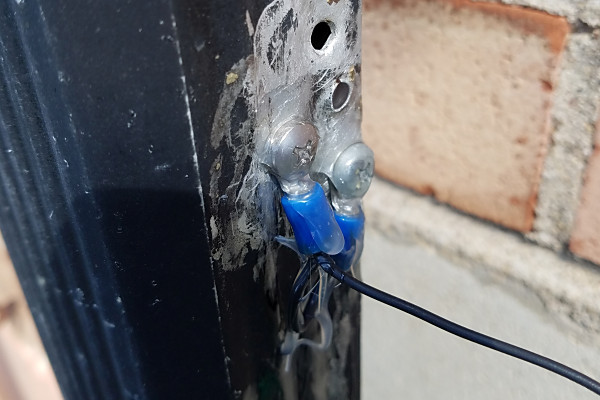Like many of you around the world, I’m under a stay-at-home order, due to the pandemic. Taking advantage of my new-found spare time, I decided to take care of some overdue antenna maintenance.
I’ve been using my rainspout as my main antenna at home since 1993. It’s a compromise antenna, but it has given me a way to get on the air from my real estate-challenged home. Normally, I do some routine maintenance on it annually, but I’ve been lax lately. It’s been about two years or more since I’ve cleaned up the connections. This was the perfect time to get caught up.
My normal maintenance routine is to re-do the connections at the downspout. The connections are subject to exposure to the elements on the outside and rainwater coming down the inside. The downspout is on a south-facing side of the house, so the sealant on the connections also takes a beating from the sun.
Sometimes, my maintenance reminder is when I notice a change in antenna performance. Typically, it’s a change in the tuning. I might notice, for example, problems loading up on one or more bands. This time, it was an increase in noise levels.
So, I headed out to the downspout and removed the screws I use to make the connection. I had to scrape off enough of the sealant I use to get a screwdriver in there. Next, I took some light sandpaper and sanded around the connection points. A few times over the years, I drilled new holes for the connections. This time, I just needed to clean things up a bit.
I use two ring lugs, jumpered together, to make the connections (see photo). My rationale is that two connections are better than one. If needed, I replace the ring lugs and the screws, but this time, they were still in good shape. I just cleaned them up a bit and reinstalled them. I finished up by resealing everything with a generous amount of Goop® sealant/adhesive.

Next, I moved indoors and turned my attention to the ground connections.
I have a 1/2-inch copper pipe that I use as a ground bus for my station. The pipe runs across the back of my radio desk to an incoming cold water pipe about 6 feet away. I use hose clamps and braided strap to make the connections to it. The 1:1 unun that feeds the wire out to the downspout is also grounded to the pipe with a braided strap and a hose clamp. The pipe itself is connected to the incoming water pipe with hose clamps and a short braided strap.
I couldn’t remember the last time I cleaned up these connections, so, it was time to get busy. I removed the connections to the copper pipe ground bus and cleaned up the pipe with light sandpaper and steel wool. I reinstalled everything, making sure the connections were tight.
Turning on my transceiver, I was pleasantly surprised with the fruits of my efforts. My local noise levels have always been high, and 40M has been the worst lately. The noise was S5 or S6 at times, but now it was down to S1 or S2. The noise on 80M was also an S unit or two lower.

I wish I had taken care of this maintenance sooner. Next time, I’ll try not to procrastinate.
Stay safe in these difficult times. I’ll see you on the air.
73, Craig WB3GCK

I once used a two story aluminum downspout as an antenna. I didn’t have a fancy ground system like yours. Instead, I drove a 4 foot length of galvanized mast in the ground at the bottom of the downspout and ran a wire from it in the basement window to the station (and tuner). It was about a 6 ft run. It was a good way to keep the soil around the ground rod moist. It tuned up best on 20 meters.
LikeLiked by 1 person